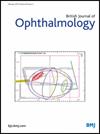Outcomes of intraluminal ripcord removal from Paul glaucoma implants
IF 3.5
2区 医学
Q1 OPHTHALMOLOGY
引用次数: 0
Abstract
Background/aims To investigate the efficacy and safety of intraluminal ripcord suture removal (ROS) from the Paul glaucoma implant (PGI). Methods A retrospective cohort study involving all PGI ripcord removal cases at a single centre between 1 January 2018 and 1 November 2023. The primary outcome was defined as a ≥20% reduction in intraocular pressure (IOP), or a decrease in IOP-lowering medications, at 3 months post-ROS. Results 145 eyes of 131 patients were included. The mean interval between PGI implantation and ROS was 181.9±131.4 days. 70.3% of eyes met the primary endpoint of success, with second tubes and infero-nasal tube placement significantly associated with reduced success (p<0.05). Compared with the pre-ROS mean IOP (19.5±6.7 mm Hg), the post-ROS IOPs at 1 week, 1 and 3 months were significantly reduced to 12.7±7.4 mm Hg, 15.3±6.1 mm Hg and 13.7±5.3 mm Hg, respectively (p<0.0001). Similarly, the number of IOP-lowering medications was significantly reduced to 0.44±0.97, 0.75±1.18 and 1.12±1.30, respectively (p<0.005). Post-ROS complications included clinically significant hypotony (n=10, 6.9%), of which 6 eyes (4.1%) required surgical ripcord re-insertion, tube shunt occlusion (n=2, 1.4%) and post-ROS uveitis (n=1, 0.69%). We found no predictive factors for post-ROS hypotony, including the time of ROS since PGI surgery. Conclusions ROS from PGI resulted in at least 20% IOP or medication reduction in over 70% of eyes. Second and inferonasal tubes had reduced success. Clinical hypotony is the most common complication, without association with the time of stent removal since PGI implantation. Data are available upon reasonable request.保罗青光眼植入物腔内肋条切除的疗效
背景/目的探讨Paul青光眼植入物(PGI)腔内开窗缝合去除术(ROS)的有效性和安全性。方法回顾性队列研究,纳入2018年1月1日至2023年11月1日在单一中心进行的所有PGI剖腹索切除病例。主要终点定义为ros后3个月眼内压(IOP)降低≥20%,或降低眼压药物用量减少。结果纳入131例患者145只眼。PGI植入与ROS的平均间隔时间为181.9±131.4天。70.3%的眼睛达到了主要成功终点,第二管和下鼻管放置显著降低了成功率(p<0.05)。与ros治疗前的平均IOP(19.5±6.7 mm Hg)相比,ros治疗后1周、1和3个月的IOP分别降至12.7±7.4 mm Hg、15.3±6.1 mm Hg和13.7±5.3 mm Hg (p<0.0001)。同样,降低眼压药物的数量也显著减少,分别为0.44±0.97、0.75±1.18和1.12±1.30 (p<0.005)。ros术后并发症包括临床显著性低斜视(n=10, 6.9%),其中6只眼(4.1%)需要手术重新插入伞索、分流管阻塞(n=2, 1.4%)和ros术后葡萄膜炎(n=1, 0.69%)。我们没有发现ROS后低电位的预测因素,包括PGI手术后的ROS时间。结论PGI的ROS导致超过70%的眼睛至少20%的IOP或药物降低。第二鼻管和鼻间管的成功率较低。临床低斜视是最常见的并发症,与PGI植入术后支架取出时间无关。如有合理要求,可提供资料。
本文章由计算机程序翻译,如有差异,请以英文原文为准。
求助全文
约1分钟内获得全文
求助全文
来源期刊
CiteScore
10.30
自引率
2.40%
发文量
213
审稿时长
3-6 weeks
期刊介绍:
The British Journal of Ophthalmology (BJO) is an international peer-reviewed journal for ophthalmologists and visual science specialists. BJO publishes clinical investigations, clinical observations, and clinically relevant laboratory investigations related to ophthalmology. It also provides major reviews and also publishes manuscripts covering regional issues in a global context.

 求助内容:
求助内容: 应助结果提醒方式:
应助结果提醒方式:


